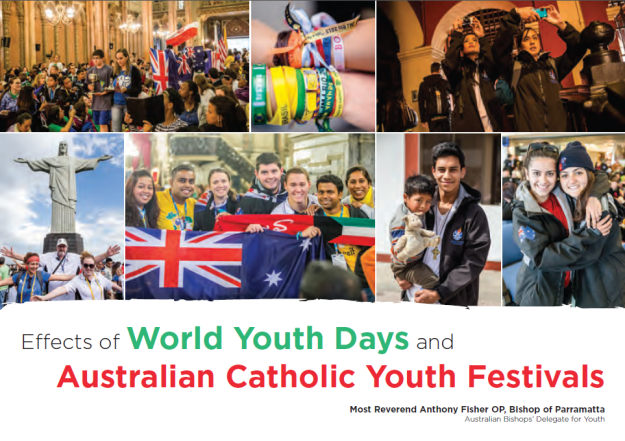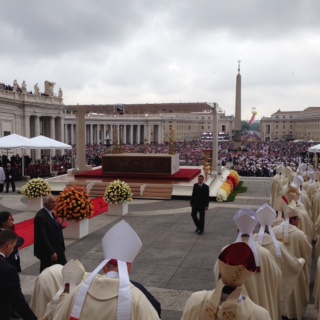Since around 2000 and especially since the World Youth Day (WYD) in Sydney in 2008, the Church in Australia has put a lot of energy into promoting the attendance of young people at the WYDs held internationally every three years. Australia has also now begun its own cycle of national events (the Australian Catholic Youth Festivals or ACYFs), also slated to occur every three years and modelled substantially on WYD. A question that is commonly raised by priests, educators, youth ministers and people is: is it all worth it – and what is the evidence? I encourage you to download and read my new paper here.
Homily – Feast of Pentecost, St Patrick’s Cathedral, Parramatta, 8 June 2014
This afternoon in Rome Pope Francis will host a prayer meeting for peace with the Patriarch Bartholomew I of Constantinople, the President of Israel, Shimon Peres, and the President of the Palestinian Authority, Mahmoud Abbas. This follows his impromptu invitation to the three when he was in the Middle East a fortnight ago. In recent times Pope Francis has focused his energies on promoting unity and peace in troubled parts of the world, such as Palestine, Syria, Ukraine and the Central African Republic, where 18 people sheltering with their priest in a Catholic church were killed by a rebel militia just this week.
Oceania Bishops’ Meeting, Thursday – Catholic Social Teaching & Family Synod
Catholic social teaching helping democracy
The first session of Oceania bishops meeting today was led by a Fijian bishop. He discussed how Catholic social teaching can help emerging democracies in the Pacific. In view of recent Federal budget we have our own challenges in applying Christian principles to politics and finances in Australia too!
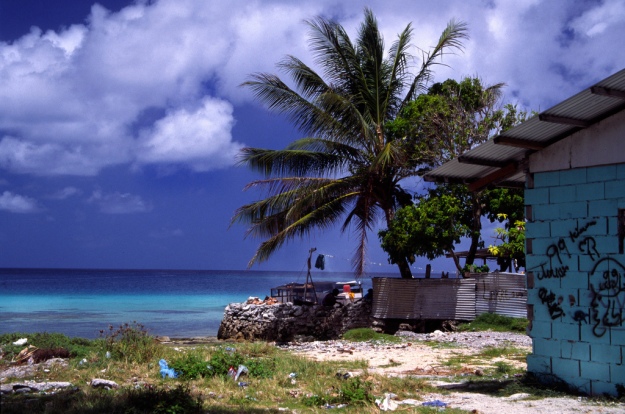
Poverty in Pacific Islands Photo: Stefan Lins Source: Creative Commons FLICKR
Family Synod
The second session today discussed responses of bishops and people to consultations for coming Family Synod. Need for new pastoral approaches, a “nuptial catechesis” faithful to the teaching of Christ and the Church and accessible to all, touching hearts and shaping lives, sporting struggling marriages and families. Holy Family of Nazareth, pray for us!
Secular Culture
Bishops addressing estrangement between the Gospel of life and love and our increasingly secular culture. Loss of credibility due to clergy abuse crisis and mishandling. Our culture values freedom above all, disconnected from nature, commitments and ethics. A culture of temporary intimacies, variety, no strings attached (or only loosely attached). Challenge of freedom-truth-love connection has been constant theme of last three popes. How are we to draw people into willing self-giving and persevering commitments? Christ our hope!
Can Mass and Prayer be the new normal for youth?
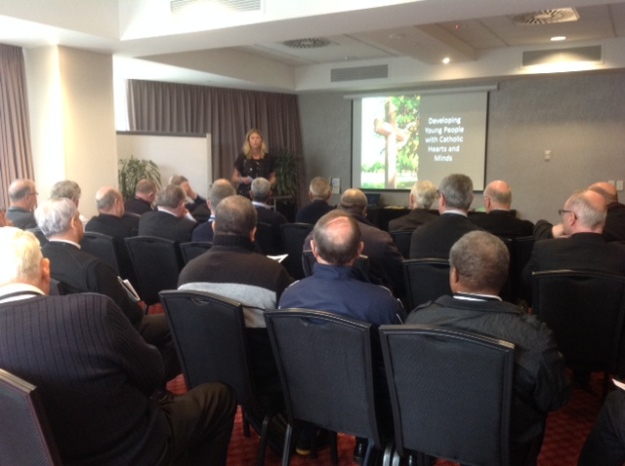
Rachel Pitcaithly Source: Supplied
Yesterday, I attended brilliant workshop by an inspiring Catholic school teacher, Rachel Pitcaithly about, “Developing young people with Catholic Hearts and Minds”. She reported on extraordinary success in a Christchurch boys college in getting the boys praying and attending Mass as the new normal. Lots of ideas here to be trying back in Australia!
Some of the ideas that Rachel brought up yesterday have been discussed in this article in 2012 by Jonathan Doyle (with a significant contribution from Rachel), “Catholic Schools and the Sacrament of Reconciliation – A bridge too far?”
Wednesday: Hakas (with Video), Pastoral Planning, Earthquakes, Mass & St Mathias

This morning the Pacific bishops discussed two subjects: pastoral planning – and earthquakes! Then we had Mass with students from all the secondary schools of the diocese, followed by another ferocious haka from the boys of St Patrick’s College Wellington. Archbishop Adrian Smith of Honiara in the Solomon Islands preached a very funny homily inspired by today’s feast of St Matthias, the first person called to succeed the apostles. He challenged the young people to take their turn as apostles – some even as bishops.
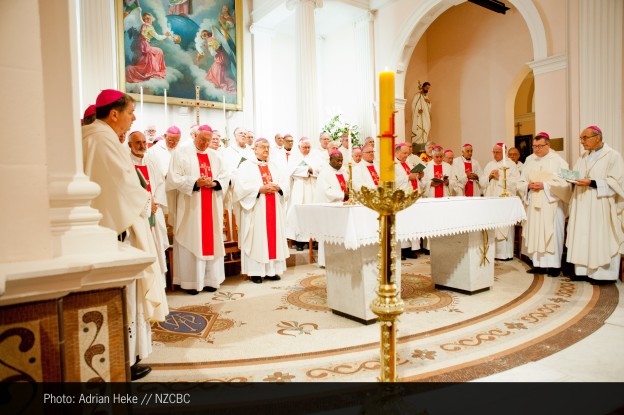
Photos: Federation of Catholic Bishops Conferences of Oceania
In last night’s blog, I talked about opening of the Federation of Catholic Bishops Conferences of Oceania. Here are some of the pictures taken by Adrian Heke and courtesy of the New Zealand Catholic Bishops Conference.
Greetings from New Zealand
Kia Ora! Greetings from New Zealand / Aeotora. I am at the Federation of Catholic Bishops’ Conferences of Oceania in Wellington for the four-yearly meeting of all the bishops of Oceania.

Photo of Aoraki / Mount Cook. SOURCE WIKIPEDIA COMMONS Photo: David Briody
Last night we were given a pōwhiri or ceremonial welcome by the local Maoris. There were many speeches, songs (we sung the Salve Regina and the Pater Noster in reply to the Maori songs). As is the custom, noses were pressed and hands shook, followed by Mass in Sacred Heart Cathedral and then a hākari (feast). There is a very strong sense of the Church of the Pacific amongst us and even the tiniest island nations have their bishop or administrator here.
Today Bishop Eugene Hurley of Darwin led a very moving discussion of Australian refugee policy and off-shore detention centres on Pacific islands. The bishops of places such as Manus Island and Nauru also spoke about the impacts on their communities. There was a strong sense that Australia’s present policy is cruel and that we could do much better. This confirmed the Australian bishops’ statement of last week. As Jesus challenges us in the Gospel of Matthew, When I was a stranger did you welcome me? (Mt 25:35)
I attended an interesting workshop analysing all the evidence about Gen Y and how connected / disconnected they are from the Church. Good discussion of what works in bringing them closer to Christ, his sacraments and his community. St John Paul would be pleased!
Departing Rome: A Final Reflection
As I depart from Rome after this historic event I offer a final two-part reflection on the ministry of Pope and John Paul II’s visit to Australia.
The Gospels offer us a number of very moving vignettes of Jesus’ encounters with the first predecessor of Sts John XXIII & John Paul II, St Peter: the call to “Come follow me & I will make you a fisher of men”; Peter’s profession of faith “You are the Christ, the Son of the living God” and Jesus’ response “You are Peter, the bedrock on which I’ll build my Church… I give you the keys to bind & loose”; Jesus’ further charges to Peter “Be not afraid… Confirm the brethren… Do this in memory of me… Feed my sheep… Try again: cast your net into the deep… Go out to all the world & proclaim the Gospel.” It is to texts such as these that we return time & again to discover role of popes who would be saints.

The Delivery of the Keys by Pietro Perugino. (Source WIKI: Public Domain)
Perhaps Jesus’ most touching encounter with the first pope was after his Resurrection. As Jesus had predicted, Peter had three times denied knowing him. Now Jesus requires him three times to profess his love. Peter does so immediately. Rather than reminding him about his failures Jesus presses him about what he will do next, do now, do instead.
At first Peter doesn’t understand what this is all about, but Jesus gives him intimations about his future & about the future of the Petrine office. You will lead the Church in difficult times, He warns. You will be led where you’d rather not go. You will suffer in the process. You will spend yourself completely for God & the Church.
John Paul II’s visit to Australia.
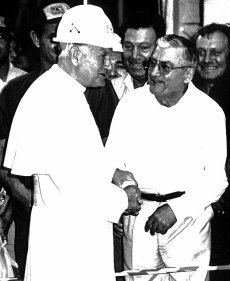
Pope John Paul II speaking with workers at the Seven Hills Transfield factory in 1986. (Source: parra.catholic.org.au Photo: The Catholic Weekly )
St John Paul’s longest apostolic journey, of the many he made, was in 1986 when he travelled 30,000 miles to Bangladesh, Singapore, Fiji, New Zealand, the Seychelles & of course Australia. In Sydney he held hands & danced in a conga-line with youngsters in jeans; in Melbourne he conducted an impromptu Q&A with primary school kids; in Alice Springs he encouraged Aboriginal Australians in their struggle for justice & reconciliation; in Brisbane he visited a hospital & cradled a koala; and in my own Diocese of Parramatta – then only a few months old – he wore a hard hat in a factory & told workers about the dignity of work. He made a deep impression upon Australians.

The Holy Father holds a koala in Brisbane during his visit to Australia in 1986. ( Photo: The Catholic Weekly Source: parra.catholic.org.au)
When Jesus told Peter about his mission as Pope – Papa for the Church & Vicar of Christ – he said he must feed or shepherd the sheep of Christ’s flock. But he added that he must feed the lambs. The young Christians that would come in the future mattered a lot to the Risen Christ. How was Peter to tend the lambs? World Youth Day was one of John Paul the Great’s brilliant pastoral moves in Petrine feeding of the lambs – one which we experienced in Australia in 2008 at the instance of his successor, Pope Benedict. Two great shepherd popes, Benedict and Francis, joined together yesterday to canonise two great shepherd popes, John and John Paul. Let us rejoice and be glad, Alleluia!
Canonisation in Pictures and Video
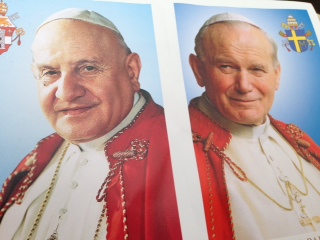
Two Pope Saints
Good Pope John & John Paul the Great have just been canonised. All around the city there were crowds gathered at sites with screens as the area around St Peter’s filled with a million pilgrims. It was a wonderful atmosphere of excitement and prayer. Many slept out overnight amidst fog and threats of rain but in very good spirits. Many streets are closed off and it is was very difficult even for the concelebrating bishops to get near the basilica. Everywhere there were groups singing and praying, with banners or flags, with helicopters overhead, ‘portaloos ‘and security on the ground, all very much like a World Youth Day.
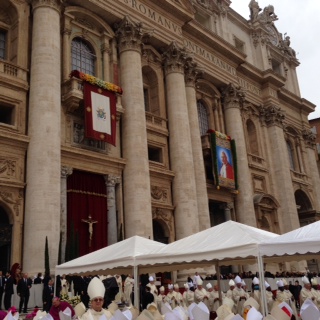
A thousand Bishops were in attendance and a million faithful.
Before we processed out it was good to see my fellow brother Bishop (and formerly from our Diocese), Bishop of Toowoomba, Robert McGuckin.
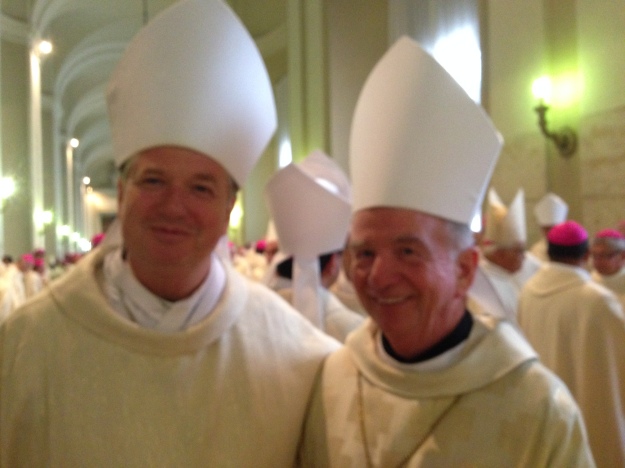
Bishop Bob McGuckin, Bishop of Toowoomba and I before we process out.

Bishops prepare to process outside
Before Mass, we are prayed the Chaplet of Divine Mercy. It started to rain lightly but as St John Paul II said on one such occasion, “What does a little rain matter? We are not made of sugar.”
It was a day of four popes, two living here on earth and two declared saints in heaven. Emeritus Pope Benedict joined Pope Francis as Pope John Paul II & Pope John XXIII were proclaimed saints. As Pope Emeritus Benedict joined us and there was a great cheer amongst the constant ringing of bells. There were many heads of state arriving – including the Italian & Polish presidents.
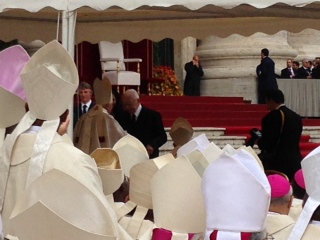
Pope Emeritus Benedict greets dignitaries.
Then the moment came where Pope Francis proclaimed these blesseds as saints, with the relics we were now in the company of two of the greatest men of the 20th century.

Pope Francis
In his homily Pope Francis reminded us that these men lived through tragic events of the 20th century but were not overwhelmed by them. That they were Popes who brought us hope and joy.
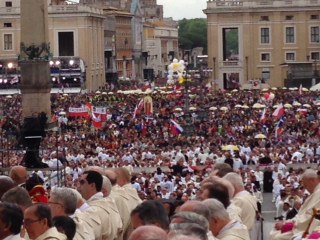
The faithful receive communion
After Mass finished Pope Francis thanked the many who were involved in the organisation, including the media for allowing people at home to experience the occasion.

Relics: In the company of two new saints: Pope John & Pope John Paul II
I was able to visit and pray at the tombs of Pope St John XXIII and Pope St John Paul. I prayed for you and your intentions.
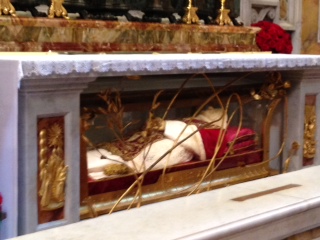

Tomb of Pope John Paul II

After the Mass I prayed for you all at the tombs of Sts John Paul II & John XXIII .

